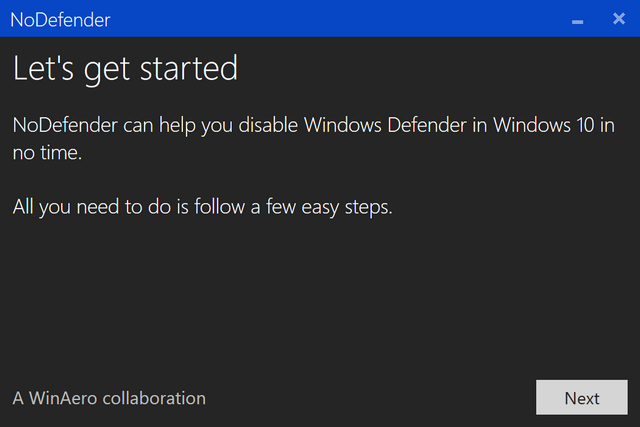Nodefender Windows 10

Jan 18, 2019 - I am running F-Secure and Windows 10 tells me that I have no antivirus protection! The solution is a free program called NoDefender.exe. By far the most effective and clean way to permanently disable Windows Defender in Windows 10 is via Group Policy, as described by Aaron Hoffman. Unfortunately, Windows 10 Home lacks the necessary tools. Here's a registry file that contains the changes made by gpedit.msc on a Windows 10 Pro machine. It's been tested on Windows 10 Home as well.
How to Turn On or Off Windows Defender Antivirus in Windows 10 Windows Defender Antivirus helps protect your PC against malware (malicious software) like viruses, spyware, and other potentially unwanted software. Malware can infect your PC without your knowledge: it might install itself from an email message, when you connect to the Internet, or when you install certain apps using a USB flash drive, CD, DVD, or other removable media. Some malware can also be programmed to run at unexpected times, not only when it's installed. Windows Defender is included with Windows and helps keep malware from infecting your PC in two ways: • Providing real-time protection. Windows Defender notifies you when malware tries to install itself or run on your PC. It also notifies you when apps try to change important settings.
• Providing anytime scanning options. Windows Defender automatically scans your PC for installed malware on a regular basis, but you can also start a scan whenever you want. Windows Defender automatically removes (or temporarily quarantines) anything that's detected during a scan. In Windows 10 you can, but it will only be temporary. Windows will automatically turn real-time protection back on if it's off for a while.
For Windows 10, Microsoft has revamped Windows Defender and combined it with Microsoft System Center Endpoint Protection. Unlike with Microsoft System Center 2012 R2, there will be no System Center Endpoint Protection client to deploy to Windows 10 machines because Windows Defender is built into the operating system and enabled by default. In addition to simplified deployment, Windows Defender contains several improvements. The most important improvements to Windows Defender are: • Early Launch Antimalware (ELAM) compatible. After Secure Boot has verified that the loading operating system is trusted, ELAM can start a registered and signed antimalware application before any other operating system components. Windows Defender is compatible with ELAM.
• Local context for detections and centralized sensory data. Unlike most antimalware software and previous versions of Windows Defender, Windows Defender in Windows 10 reports additional information about the context of discovered threats.
This information includes the source of the content that contains the threat as well as the historical movement of the malware throughout the system. When collection is complete, Windows Defender reports this information (when users elect to enable cloud-based protection) and uses it to mitigate threats more quickly. • User Account Control (UAC) integration.
Windows Defender is now closely integrated with the UAC mechanism in Windows 10. T racks serial number and authorization code free. Whenever a UAC request is made, Windows Defender automatically scans the threat before prompting the user, which helps prevent users from providing elevated privileges to malware. • Simplified management.

In Windows 10, you can manage Windows Defender much more easily than ever before. Manage settings through Group Policy, Intune, or Configuration Manager. This tutorial will show you how to completely turn on or off Windows Defender for all users in Windows 10.
You must be signed in as an administrator to be able to turn on or off Windows Defender. When you install some 3rd party antivirus (AV) programs, they may automatically turn off Windows Defender. In this case you may not be able to turn on Windows Defender again until the 3rd party AV program has been disabled (turned off) or completely uninstalled. As long as you have Windows Defender turned on and real-time protection enabled, you're good to go.:)I also followed the steps ('Disabled' the Turn off Windows Defender) but it seems that Windows Defender doesn't seem to stay on.